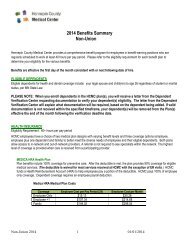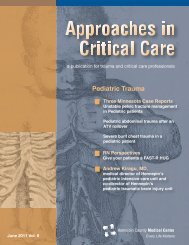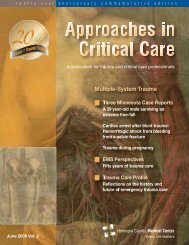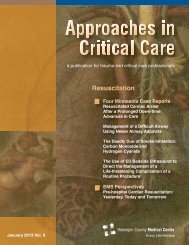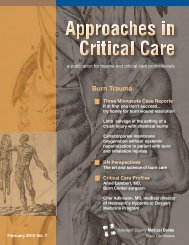Ischemic Stroke - Hennepin County Medical Center
Ischemic Stroke - Hennepin County Medical Center
Ischemic Stroke - Hennepin County Medical Center
Create successful ePaper yourself
Turn your PDF publications into a flip-book with our unique Google optimized e-Paper software.
Case Reports<br />
Guidelines regarding early recognition and<br />
treatment of CVA are well established. Intraarterial<br />
thrombolysis (IAT) has been shown to<br />
improve outcomes in a select group of patients<br />
with thrombosis of the middle cerebral artery<br />
(MCA). Class I recommendations by the<br />
American <strong>Stroke</strong> Association include IAT for<br />
patients who are not candidates for intravenous<br />
thrombolysis and who present to a<br />
stroke center with thrombus in the MCA within<br />
6 hours of symptom onset. This case involves<br />
a young patient who underwent delayed IAT<br />
with a successful outcome.<br />
Case report<br />
A 29 year-old male with no significant past<br />
medical history presented to a local emergency<br />
department with sudden onset of severe leftsided<br />
headache, profound right-sided weakness<br />
and slurred speech about 30 minutes<br />
after sexual intercourse. A head CT showed no<br />
evidence of infarction or hemorrhage. The<br />
patient’s symptoms completely resolved after<br />
symptomatic treatment of the headache (about<br />
1-2 hours from onset) and he was discharged<br />
to home. The patient fell asleep around 4:00<br />
a.m. feeling normal. He awoke at 10:00 a.m.<br />
with aphasia and right-sided weakness and<br />
returned to the hospital. A repeat head CT at<br />
this time showed small hypodensities in the<br />
region of his left MCA. He was transferred to a<br />
stroke center with persistent right-sided facial<br />
droop and profound weakness of the right<br />
upper and lower extremities.<br />
Upon arrival at the stroke center, his vital signs<br />
were temperature 35.9° Celsius, BP 153/77,<br />
HR 75, RR 17, and O2 saturation of 100%. An<br />
emergent CT perfusion showed a large perfusion<br />
deficit with a small area of infarction in the<br />
territory of the left MCA, consistent with a large<br />
area of at-risk but salvageable brain tissue. CT<br />
angiogram showed a small focal thrombus in<br />
the proximal segment of the MCA. Emergent<br />
MRI confirmed a small amount of existing<br />
stroke in the left MCA distribution. Cerebral<br />
angiogram by the neurointerventionalist<br />
revealed an occlusion of the left M1 with a<br />
string of delayed flow around the thrombus.<br />
Low-dose intra-arterial alteplase (2 mg) was<br />
administered directly into the clot approximately<br />
17 hours after his initial presentation and<br />
just over 12 hours after he went to sleep feeling<br />
normal again after the first transient<br />
ischemic attack (TIA). Intra-arterial thrombolytic<br />
treatment was chosen over mechanical<br />
embolectomy despite the late time window<br />
because a small clot burden was seen that<br />
would likely respond to the thrombolytic treatment.<br />
The angiogram showed partial resolution<br />
of the clot and significant improvement in distal<br />
perfusion of his left MCA. (See Figure One on<br />
page 10.)<br />
Intravenous Integrilin ® was administered to<br />
prevent vessel reocclusion and facilitate further<br />
clot lysis. A follow-up angiogram showed a<br />
spontaneous dissection in the area of the<br />
thrombus, which was thought to be the cause<br />
of occlusion. At a later date, the patient underwent<br />
stenting of his left M1 dissection and is<br />
currently on aspirin and Plavix ® . Other workups,<br />
including labs for hypercoaguable disease<br />
and imaging for cardiac sources of thromboembolism,<br />
were negative. The remainder of<br />
the patient’s hospital course was unremarkable<br />
and at the one-year follow-up, the patient’s<br />
only remaining deficit was an occasional<br />
tremor of his right hand at rest. He is back to<br />
work and otherwise living a normal life.<br />
Discussion<br />
American <strong>Stroke</strong> Association class I recommendations<br />
for IAT include patients presenting<br />
within 6 hours of symptom onset with ischemic<br />
CVA to the MCA, who are not candidates for<br />
intravenous thrombolysis (IVT). Class I recommendations<br />
also include IAT by a qualified<br />
interventionalist at a center with access to<br />
cerebral angiogram. Preliminary data show<br />
significant benefit of IAT versus placebo. One<br />
example is the PROACT II trial, which has<br />
shown favorable results for IAT use. One<br />
aspect of this study compared patients who<br />
Approaches in Critical Care | December 2008 | 9





